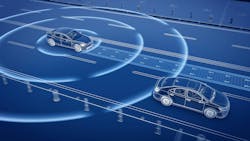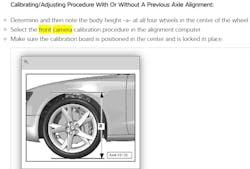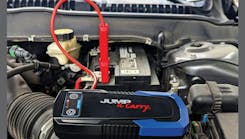ADAS calibrations - dynamic and static
Did you know that most automobile accidents happen because of human error? Advanced Driver Assistance Systems (ADAS) were developed for safer driving by adding technology to assist the driver. That assistance reduces human input, therefore, human error.
In the early 70s, I attended a trade school and was in an automotive technician’s class. Our instructor, Mr. Hardy, announced that he believed the future, our future, would develop a car that drove itself. He explained that it would have some kind of camera that would follow the lines on the road. He continued, painting a futuristic picture of the automotive industry that we all struggled to believe. We were all familiar with the Batmobile, the Love Bug, and The Jetsons’ flying car, but they were fictional vehicles made up by imaginations like Stephen King’s with his 1958 Plymouth Fury, Christine. We respected Mr. Hardy and thought of him as the smartest car guy on the planet, but still, we struggled with his vision. Now here we are, 50 years later and we are seeing vehicles that are doing exactly what Mr. Hardy predicted.
My first experience with the lines on the pavement was in a rented SUV on a curvy road through the hills. When I would get a little too close to the center, or shoulder line, ADAS would “assist” me back to the middle of the lane. Not thinking about the vehicle being equipped with ADAS, I thought something was wrong with the steering or maybe a bad tie rod or something was coming loose. I was about ready to call the rental car agency. When I got on a major highway and passed a slower car without using my turn signal, my seat buzzed me and I noticed a light flash on the dash. That’s when it hit me, ADAS! Of course, I then spent the next 100 miles or so experimenting with how the system reacted.
ADAS is perceived to be a new thing, but it really was under development when I was in Mr. Hardy’s class in the early 1970s with the introduction of anti-lock brake systems (ABS) to the industry. Other early ADAS include electronic stability control, blind spot information systems, lane departure warning, adaptive cruise control and traction control.
ADAS are categorized into six different levels based on the amount of automation and the scale provided by the Society of Automotive Engineers (SAE):
Level 0: No control over the car and only provides information for the driver to interpret on his/her own. Warning lights, information, etc.
Level 1 and 2: Very similar in that they both have the driver do most of the decision making. The difference is level 1 can take control over one functionality and level 2 can take control over multiple and aid the driver. ADAS that are considered level 1 are adaptive cruise control, emergency brake assist, automatic emergency brake assist, lane-keeping, and lane centering. ADAS that are considered level 2 are highway assist, autonomous obstacle avoidance, and autonomous parking.
Level 3 to 5: The amount of control the vehicle has increases; level 5 being where the vehicle is fully autonomous.
Simply, the levels can be roughly understood as:
Level 1: Hands-on/shared control
Level 2: Hands off
Level 3: Eyes off
Level 4: Mind off
Level 5: Steering wheel and nap time optional
There are six main ADAS sensors used by all OEMs: camera, radar and ultrasonic.
- Forward camera
- Forward radar (long/short range)
- Rear camera
- 360 view/birds eye view cameras
- Side view / blind spot monitoring (radar)
- Park assist (ultrasonic)
Workflow
In today’s automotive repair world, there is now a common workflow to follow for most scenarios as the diagram shows below. First is pre-scan where it’s a bumper-to-bumper check for trouble codes. Then, there’s the diagnosis to understand the cause of the trouble code. Afterward, we repair the problem and recalibrate the system. Lastly, there’s the post-scan where we verify the repair and operation.
On ADAS issues, the workflow would be the same. We will concentrate on the recalibration steps.
What is ADAS Calibration?
ADAS calibration is an important potential shop revenue stream. Virtually every car on the road today has a system that will require calibration after component replacement. Think about how much that can add to a shop’s annual revenue.
Three methods of ADAS calibration:
- Static calibration: requires a target system used with a scan tool and is performed in the service bay.
- Dynamic calibration: simply connect scan tool and drive car.
Note: Static vs. dynamic calibration ADAS boils down to in the bay or test drive, or target required or scan tool only. - Initialization: enter information into the car via scan tool.
ADAS calibration tools
- Scan tool: required for all three calibration methods
- Proper calibration target: required for static calibration only
- OEM procedures: these are critical. An information system like ShopKey Pro has charts (see below) to inform you what is needed to calibrate the component. You will also find specifications, component location and operation, wiring diagrams, how to remove and replace components, and step-by-step calibrating procedures.
Information is Key
When available, Snap-on scan tools have OEM repair information built right in, guiding you through the step-by-step calibration process. Take a look at the sample screenshots below of a static calibration of a blind spot radar on a 2021 Toyota Rav4.
How long does ADAS calibration take?
That’s a tough question with an easy answer. It really does vary from each manufacturer and the method required. The best bet is to use a labor-estimating guide as seen below. The calibration for an Audi lane change assist is 1.2 hours.










